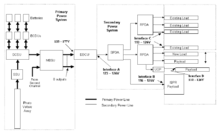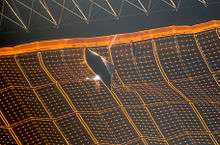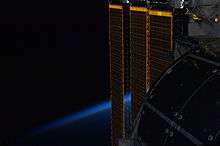Electrical system of the International Space Station
.jpg)
The electrical system of the International Space Station is a critical resource for the International Space Station (ISS) because it allows the crew to live comfortably, to safely operate the station, and to perform scientific experiments. The ISS electrical system uses solar cells to directly convert sunlight to electricity. Large numbers of cells are assembled in arrays to produce high power levels. This method of harnessing solar power is called photovoltaics.
The process of collecting sunlight, converting it to electricity, and managing and distributing this electricity builds up excess heat that can damage spacecraft equipment. This heat must be eliminated for reliable operation of the space station in orbit. The ISS power system uses radiators to dissipate the heat away from the spacecraft. The radiators are shaded from sunlight and aligned toward the cold void of deep space.
Solar array wing
.jpg)
Each ISS solar array wing (often abbreviated "SAW") consists of two retractable "blankets" of solar cells with a mast between them. Each wing uses nearly 33,000 solar cells and when fully extended is 35 metres (115 ft) in length and 12 metres (39 ft) wide.[1] When retracted, each wing folds into a solar array blanket box just 51 centimetres (20 in) high and 4.57 metres (15.0 ft) in length.[2] The ISS now has the full complement of eight solar array wings.[3] Altogether, the arrays can generate 84 to 120 kilowatts.[4]
The solar arrays normally track the Sun, with the "alpha gimbal" used as the primary rotation to follow the Sun as the space station moves around the Earth, and the "beta gimbal" used to adjust for the angle of the space station's orbit to the ecliptic. Several different tracking modes are used in operations, ranging from full Sun-tracking, to the drag-reduction mode ("Night glider" and "Sun slicer" modes), to a drag-maximization mode used to lower the altitude. See more details in the article at Night Glider mode.
Batteries
Since the station is often not in direct sunlight, it relies on rechargeable nickel-hydrogen batteries to provide continuous power during the "eclipse" part of the orbit (35 minutes of every 90 minute orbit). The batteries ensure that the station is never without power to sustain life-support systems and experiments. During the sunlit part of the orbit, the batteries are recharged. The batteries have a design life of 6.5 years which means that they must be replaced multiple times during the expected 20-year life of the station.[5] The batteries and the battery charge/discharge units are manufactured by Space Systems/Loral (SS/L),[6] under contract to Boeing.[7]
Power management and distribution

The power management and distribution subsystem operates at a primary bus voltage set to Vmp, the peak power point of the solar arrays. As of December 30, 2005, Vmp was 160 volts DC (direct current). It can change over time as the arrays degrade from ionizing radiation. Microprocessor-controlled switches control the distribution of primary power throughout the station.
The battery charge/discharge units (BCDUs) regulate the amount of charge put into the battery. Each BCDU can regulate discharge current from two battery ORUs (Orbital Replacement Unit, a series-connected pack of 38 Ni-H2 cells), and can provide up to 6.6 kW to the Space Station. During insolation, the BCDU provides charge current to the batteries and controls the amount of battery overcharge. Each day, the BCDU and batteries undergo sixteen charge/discharge cycles. The Space Station has 24 BCDUs, each weighing 100 kg.[6]
SSU
Eighty-two separate solar array strings feed a sequential shunt unit (SSU) that provides coarse voltage regulation at the desired Vmp. The SSU applies a "dummy" (resistive) load that increases as the station's load decreases (and vice versa) so the array operates at a constant voltage and load.[8] The SSUs are provided by SS/L.[6]
DC-to-DC conversion
DC-to-DC converter units supply the secondary power system at a constant 124.5 volts DC, allowing the primary bus voltage to track the peak power point of the solar arrays.
Thermal Control
The thermal control system regulates the temperature of the main power distribution electronics and the batteries and associated control electronics. Details on this subsystem can be found in the article External Active Thermal Control System.
Station to shuttle power transfer system

The Station-to-Shuttle Power Transfer System (SSPTS; pronounced spits) allowed a docked Space Shuttle to make use of power provided by the International Space Station's solar arrays. Use of this system reduced usage of a shuttle's on-board power-generating fuel cells, allowing it to stay docked to the space station for an additional four days.[9]
SSPTS was a shuttle upgrade that replaced the Assembly Power Converter Unit (APCU) with a new device called the Power Transfer Unit (PTU). The APCU had the capacity to convert shuttle 28 VDC main bus power to 124 VDC compatible with ISS's 120 VDC power system. This was used in the initial construction of the space station to augment the power available from the Russian Zvezda service module. The PTU adds to this the capability to convert the 120 VDC supplied by the ISS to the orbiter's 28 VDC main bus power. It is capable of transferring up to 8 kW of power from the space station to the orbiter. With this upgrade both the shuttle and the ISS were able to use each other's power systems when needed, though the ISS never again required the use of an orbiter's power systems.
During mission STS-116, PMA-2 (then at the forward end of the Destiny module) was rewired to allow for the use of the SSPTS.[10] The first mission to make actual use of the system was STS-118 with Space Shuttle Endeavour.[11]
Only Discovery and Endeavour were equipped with the SSPTS. Atlantis was not equipped with the SSPTS, so could only go on shorter length missions than the rest of the fleet.[12]
References
- ↑ "Spread Your Wings, It's Time to Fly". NASA. July 26, 2006.
- ↑ "STS-97: Photovoltaic array assembly". NASA. November 9, 2000.
- ↑ "International Space Station - Solar Power". Boeing.
- ↑ Wright, Jerry. "Solar Arrays". NASA. Retrieved 2016-03-23.
- ↑ "Nickel-Hydrogen Battery Cell Life for International Space Station". NASA.
- 1 2 3 Space Systems Loral, International Space Station reference sheet, dated 2/98 (accessed May 9 2012)
- ↑ "Space Systems/Loral awarded $103 million contract to build critical power systems for the International Space Station" (Press release). Loral. July 8, 2003.
- ↑ "Options Studied for Managing Space Station Solar Array Electrical Hazards for Sequential Shunt Unit Replacement". NASA.
- ↑ "STS-118 crew interview, Station to Shuttle Power System". space.com.
- ↑ "Aft flight deck payloads switch list for handover". Ascent Checklist STS-116 (PDF). Mission Operations Directorate Flight Design and Dynamics Division. October 19, 2006. p. 174.
- ↑ "STS-118 MCC Status Report #05". NASA. August 10, 2007.
- ↑ Gebhardt, Chris (November 16, 2009). "Fuel Cell 2 issue cleared – Atlantis in perfect launch". NASAspaceflight.com.
- "Power to the ISS!". NASA. November 13, 2001.
- "Powering the Future: NASA Glenn Contributions to the International Space Station (ISS) Electrical Power" (pdf). NASA. November 2000.

